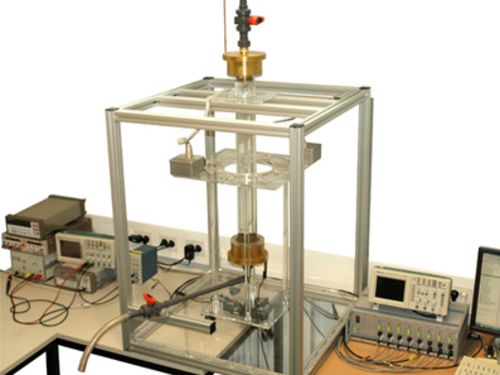Tomography is predominantly associated with computed tomography (CT), particularly with the CT scanner used for medical applications. Aside from the medical field, tomography is important in many scientific areas. The detailed investigation of the structure and composition of objects is the main reason for the development of tomographic imaging systems. For the calculation of a virtual cross section, the object to be examined is exposed to radiation or waves. As a result of the calculated virtual cross section, information about the inner structure of the object can be obtained.
Applications based on tomographic methods are so-called inverse problems. A problem is called inverse, when observed measurements are used to convert them into information about the underlying source.
 Figure 1: This image shows the realized experimental setup for magnetic tomography including all equipment used for measurement.
Figure 1: This image shows the realized experimental setup for magnetic tomography including all equipment used for measurement.
The master-thesis covers the development of an experimental setup for magnetic tomography, based on the fact, that the magnetic tomography is also interpreted as an inverse problem. More precisely, an alternating magnetic field causes an induced voltage in sensing coils. Subsequently, these induced voltages give information on the local position of the source.
To generate the alternating magnetic field, an electrolytic solution is supplied with alternating current. In the specific application, the electrolytic solution is contained in a tube made of acrylic glass (therefore, the name electrolyte-column is used). Moreover, it is because of the easy availability and handling why a sodium chloride-water-solution is used as the electrolyte. A consequence thereof is, that the electrical conductivity of sodium chloride-water-solutions is investigated in detail in this work.
At the mechanical implementation of the experimental setup for magnetic tomography, a measuring apparatus is used, that includes 8 sensor coils and is placed around the electrolyte-column. Furthermore, a two dimensional movement of the measuring apparatus relative to the fixed electrolyte-column is realized by two motorized linear stages. Instrumentation and microphone amplifiers provide the necessary amplification of the induced voltage in the sensor coils. Via the analog inputs of a sound card, the sensor signals are finally captured, processed and analysed by a computer.
The operation of the fully automated measurement on the experimental setup is provided by a graphical user interface (developed in Matlab). As shown by the final results, the positions of the coils detected by the tomographic based measurements are almost the same as the real positions, which are determined by the motorized linear stages. In conclusion it can be stated, that the requirements on the experimental setup for magnetic tomography are achieved very well.
Keywords: tomography, inverse problem, electrolyte, alternating magnetic field, sensor coil, induced voltage